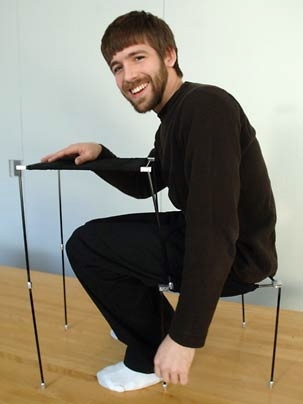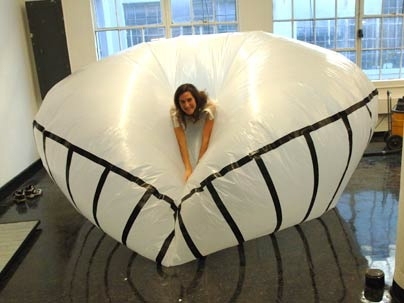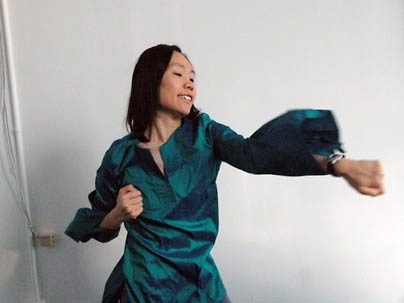MIT students are always in motion, so their projects for the advanced visual design course, Give Me Shelter, featured clothes and accessories to help navigate the gaps between work and home, self-confidence and unease, and under- or over-stimulation.
Adam Kumpf, graduate student in media arts and sciences, designed EscHome, a wearable office consisting of a chair and a desk embedded in a pair of black pants. A garment that provides the comforts of work--structure, stability, solitude--amid the pressures at home, EscHome's chair and desk are made from lightweight carbon fiber rods, aluminum joining blocks and fabric to match the pants.
Kumpf (S.B. 2005, M.Eng. 2007) deconstructed EscHome with glee. "The structural rods are hidden within small zipped pockets and situated along the femur, so they don't interfere with walking or sitting. Unzip the pockets; position the rods; in a minute, you're hiding in work."
Mary Hale, graduate student in architecture and planning, took on space, gender and mobility in her plastic dropcloth and electrician-tape pantaloons, the Monumental Helium Inflatable Wearable Floating Body Mass.
Hale, whose modeling session required a 15-minute bond with the Shop-Vac to inflate Body Mass, wanted to create body-wear that functioned like a book for mental escape, subverted physics (especially gravity), and enhanced mobility and personal ease.
Body Mass achieves all this, Hale said, tipping forward and back on her personal sea. "But it's with a twist: she who dons this body gains its lightness and freedom by assuming a culturally undesirable physical proportion--a volume at least ten times greater than her actual size. It's a means of mental escape and an envelope of new personal space," Hale said.
For Angela Chang, graduate student in media arts and sciences, the ripple of silk, the scratch of linen and the hush of polar fleece convey information about the wearer's identity and activities. The experience of a blind friend who could only hear a circus performance inspired Chang to amplify these sounds.
She designed a garment for hiding and a garment to dramatize dancing. Her wool isolation scarf is equipped with two speakers, ambient noise circuits, conductive thread, and a microphone in the back to control the volume in relation to ambient noise. It cocoons the wearer inside a white-noise bubble--like having a therapist's waiting room on your head.
Chang also designed and sewed a raw silk, bell-sleeved, dance-party shirt--with thanks to Regina Moeller, visiting associate professor of architecture, for the sewing instruction. "The basting stitch, pattern language, sewing machines--these were technologies I didn't know," said Chang.
Chang augmented the shirt's typical rustling sound with an amplification circuit, sewing two microphones inside the sleeve-ends and two speakers near the neck. Movement broadcast through the speakers dramatizes dance-floor action for the vision-impaired.
Moeller, a German artist, author and publisher, co-taught Give Me Shelter with Ute Meta Bauer, director of the visual arts program. Moeller delighted in the interdisciplinary ferment of the body-wear class, she said.
"What I loved about this class and about MIT is that the twelve students came from different fields and they all helped each other," said Moeller.
A version of this article appeared in MIT Tech Talk on January 16, 2008 (download PDF).








